The Enigmatic September 23 Birthstone Revealed
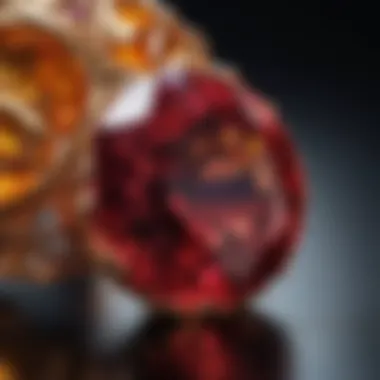
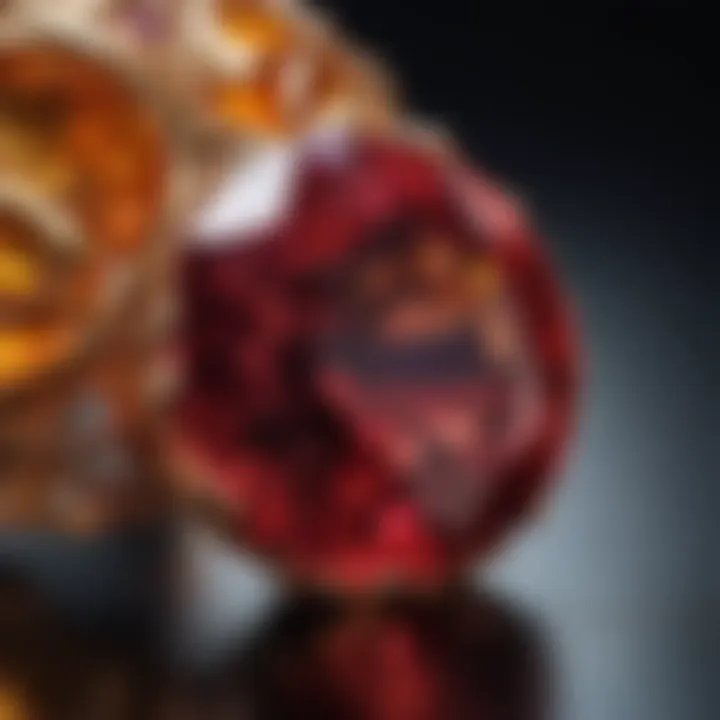
Intro
The birthstone for September 23 has long captivated not only gemstone enthusiasts but also those who are curious about their meanings and significance. These stones, often steeped in history, evoke emotions and symbolize various attributes. This article provides an in-depth look at the birthstone associated with this date. We will explore its unique features, historical context, cultural significance, and practical advice for gemstone care and acquisition.
Gemstone Overview
Definition and Characteristics
The birthstone associated with September 23 is sapphire. Known for its rich blue hue, sapphire can also appear in various colors, excluding red. This phenomenon occurs due to the presence of trace elements within the stone. The characteristic hardness of sapphire, measuring 9 on the Mohs scale, makes it a durable choice for jewelry, suitable for everyday wear.
Classification of Gemstones
Sapphires belong to the corundum mineral family, which is prevalent in various gemstone classifications. The most common types of sapphires include:
- Blue Sapphire: The most recognized variant, often treasured for its deep, intense color.
- Fancy Sapphire: Includes all non-blue colors such as pink, yellow, and green.
- Star Sapphire: Exhibits a star-like phenomenon due to needle-like inclusions, creating a fascinating visual effect.
Understanding the classification helps in recognizing their value and distinguishing quality gemstones from lesser ones.
Historical Significance
Ancient Uses and Cultural Importance
Sapphire has a rich history that extends back thousands of years. In ancient cultures, this gemstone was believed to hold protective properties. Many civilizations, including the Greeks and Romans, associated sapphires with divine favor and royalty. Ancient Persians even thought that the earth rested upon a giant sapphire, reflecting its blue hue in the sky.
Myths and Legends Surrounding Gemstones
The allure of sapphire is not limited to its physical properties. Numerous myths around this stone blush the narrative of its significance. One such legend suggests that wearing a sapphire promotes wisdom and good fortune. People often believed that sapphires could ward off envy, making them a popular choice among the elite and influential throughout history.
"The sapphire symbolizes serenity, loyalty, and nobility in various cultures."
Through the ages, the sapphire has maintained its reputation as a stone of insight and enlightenment. This duality of cultural significance and physical beauty makes it a prized gemstone.
Finale
In summary, the nature and history of the September 23 birthstone embodies much more than mere aesthetic appeal. Not only does the sapphire exemplify exceptional beauty and durability, but it also serves as a historical artifact that has influenced various cultural narratives. This understanding enhances appreciation for this precious gem, providing gemstone enthusiasts and collectors insights that go beyond surface admiration. As we delve deeper into the characteristics of sapphire, we uncover the nexus between gemology, history, and personal significance.
Prologue to Birthstones
Birthstones hold a place of significance in both cultural and personal realms. Understanding birthstones is essential, as they often reflect personality traits, emotions, and even spiritual beliefs of individuals born in specific months. This understanding provides a backdrop for appreciating the September birthstone and its unique characteristics.
Definition and Importance of Birthstones
Birthstones are gemstones that are traditionally associated with each month of the year. Each stone carries its own set of meanings, histories, and properties that have evolved over time. People often wear these stones in jewelry or keep them as keepsakes, believing they provide luck or protection.
The importance of birthstones often transcends mere aesthetics. Many consider them symbols of one's identity, tying personal significance to individuals. This can create deeper emotional connections between a person and their birthstone. In a world where personal expression is valued, these stones serve as tangible representations of self. Furthermore, they can convey meaningful messages when given as gifts, reinforcing relationships or celebrating milestones.
Historical Origins of Birthstones
The tradition of birthstones dates back to ancient cultures, particularly in the time of the Biblical text, Exodus, where the stones are described as being part of the High Priest's breastplate. It is said that these stones were used to represent the twelve tribes of Israel. The link between specific stones and months gained traction throughout history, notably during the 18th century when the modern association of each zodiac sign with a corresponding gem was solidified.
For many cultures, the history of birthstones is imbued with various meanings, often relating to healing properties or divine connections. Roman and Greek civilizations, for example, believed that wearing a birthstone during its assigned month would enhance its powers. Today, birthstones are recognized not just for their beauty, but also for their rich history and significance, making them vital components in jewelry making and personal adornment.
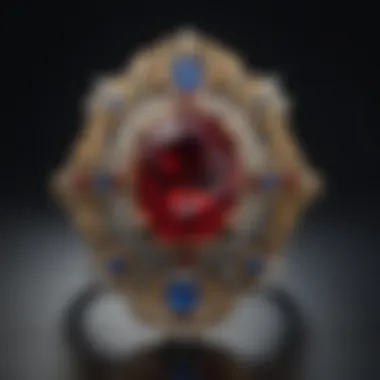

Understanding the importance of birthstones involves looking back at their definitions and historical origins. This context will enrich our exploration of the September birthstone and all it embodies.
The Birthstone for September
The September birthstone, primarily recognized as the sapphire, holds a significant position not only in the realm of gemstones but also in various cultural and historical contexts. The sapphire's deep blue hue is perhaps its most iconic aspect, symbolizing nobility, truth, and fidelity. This stone's reputation extends beyond aesthetics; it embodies a rich narrative that resonates with many facets of human history and social customs.
Understanding the significance of the September birthstone opens doors to discussions about its qualities and how those qualities translate into personal meaning for individuals born in this month. Sapphires are thought to bring wisdom and have been used traditionally in jewelry symbolizing commitment and loyalty. Thus, those who celebrate birthdays in September may feel a unique connection to this stone, understanding it as a token of sound judgment and steadfastness as they journey through life.
Preamble to the September Birthstone
The sapphire, known for its striking colors beyond blue—from pink to yellow and even white—is the star of September. Most people recognize the blue variant, but the broader category includes corundum in every hue except red, which classifies as ruby. The cultural significance of sapphires extends back to ancient civilizations, where they were often associated with royalty and divine favor.
Sapphires are often used in various jewelry pieces such as rings, necklaces, and bracelets, valued for their stunning visual appeal and durability, scoring 9 on the Mohs scale of hardness. This quality makes them an ideal choice not only for everyday wear but also for heirloom pieces, ensuring their lasting beauty. The significance of sapphires is also reflected in engagement rings since they represent lasting value and commitment.
Variations Among September Birthstones
While the sapphire stands out as the primary birthstone for September, there are noteworthy variations that enthusiasts should consider. For instance, the padparadscha sapphire, regarded for its rare combination of pink and orange, creates a captivating allure that diverges from the traditional blue. This variation can sometimes command higher prices in the market due to its rarity.
Furthermore, other forms of gemstones, such as lapis lazuli, are celebrated alongside sapphires for those who prefer alternatives. Lapis lazuli, with its deep celestial blue, carries its own rich historical significance tied to protection and wisdom.
In summary, these variations enhance the conversation surrounding the September birthstone, providing choices for individuals based on personal preferences and symbolic associations.
"The sapphire represents not only elegance but also a profound connection to history and culture that enriches its significance as a birthstone."
As both collectors and wearers navigate the world of gemstones, understanding these variations offers valuable insight, assisting in making informed choices regarding personal or gift selections.
Characteristics of the Sapphire
The sapphire is much more than just a beautiful gemstone; it embodies a range of physical, aesthetic, and geological qualities that make it significant in the world of gemstones. By understanding the characteristics of sapphires, collectors and enthusiasts can appreciate their value, beauty, and the intricacies involved in their formation and variance. This section explores the physical properties of sapphires, their color variations and implications, and how geological factors contribute to their distinctiveness.
Physical Properties of Sapphires
Sapphires belong to the corundum family, which also includes rubies. Their hardness is one of their most notable physical properties. Sapphires rank a 9 on the Mohs scale, making them exceptionally durable and suitable for daily wear in jewelry. This hardness gives them the ability to resist scratches and maintain their brilliance over time.
The clarity of sapphires is also crucial. High-quality sapphires have minimal inclusions, which can affect their overall appearance. GIA (Gemological Institute of America) uses clarity grades to assess the internal characteristics of gemstones. Moreover, the cut of a sapphire impacts its light reflection and refraction, enhancing its visual appeal. Think of facets; these geometric elements enhance the stone’s sparkle significantly.
Color Variations and Implications
When it comes to sapphires, the color is perhaps the most defining feature. Though blue sapphires are the most recognized, sapphires can appear in a spectrum of colors, including pink, yellow, green, and even colorless varieties. The color within sapphires comes from trace elements; for instance, iron and titanium lend themselves to the blue hue.
The saturation and tone of the color greatly affect the gemstone's value. A deep, vivid blue is often sought after. Conversely, lighter or overly dark tones can diminish value. Color zoning, visible in some stones, can also influence price. Collectors must evaluate each sapphire's color quality carefully to ascertain its worth.
"A sapphire's color and its saturation level dictate its market demand and value significantly."
Geological Formation of Sapphires
The formation of sapphires is a fascinating geological process. Sapphires develop under high-temperature and high-pressure conditions deep within the Earth’s crust over millions of years. They typically form in metamorphic rocks and are later found in alluvial deposits following erosion.
Regions known for sapphire deposits include Kashmir, Myanmar, and Australia. Each locale contributes unique characteristics, impacting both the physical appearance and the overall quality of the stones mined there. When purchasing sapphires, understanding their origin can provide insights into their historical significance and potential value in the market.
In summary, the characteristics of sapphires—from their physical properties to their color variations and geological formation—offer a comprehensive understanding of what makes this gemstone a compelling choice for jewelry enthusiasts and collectors alike. A keen knowledge of these elements enhances one’s ability to select, appreciate, and care for sapphires.
Cultural and Historical Significance

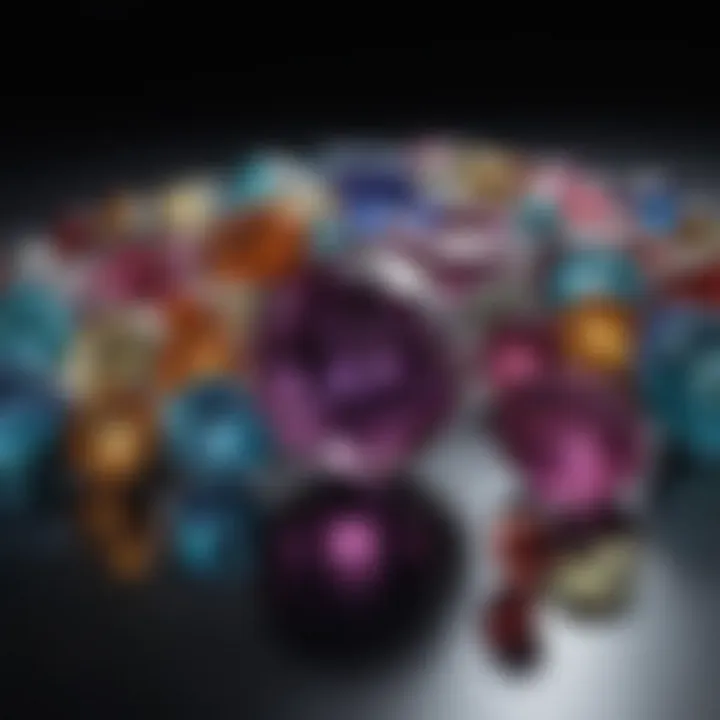
The cultural and historical significance of sapphires is vast and multifaceted. Recognized for their stunning beauty, these gemstones have held essential roles across various societies and cultures. Understanding their importance offers insight into the human connection with nature and the symbolic weight given to certain materials. This section will explore how sapphires have influenced ancient civilizations, their place within religious contexts, and how they resonate with modern symbolism.
Sapphire in Ancient Civilizations
Sapphires have been treasured since ancient times. They were often associated with royalty and divinity due to their vibrant blue color and striking appearance. In ancient Egypt, sapphires adorned crowns and ceremonial artifacts, symbolizing protection and power. Moreover, ancient Persians believed that the Earth rested on a giant sapphire, reflecting the sky's blue hue. This association showcased the stone's celestial connotation and its role as a connector between earthly and heavenly realms.
The Greeks and Romans also revered sapphires, associating them with their gods. For instance, the famous philosopher and physician, Socrates, is said to have valued this stone for its perceived healing powers and wisdom. Sapphires were frequently embedded in jewelry worn by leaders, as it was believed they could attract divine favor and ensure safe journeys.
Sapphire in Religious Contexts
In various religious traditions, sapphires symbolize purity, wisdom, and divine favor. For instance, in the Bible, the Ten Commandments were said to be inscribed on tablets made of sapphire. This association lends a spiritual depth to the stone, establishing it as a symbol of law and moral clarity. Additionally, sapphires have been incorporated into religious artifacts, signifying their importance in spiritual practices.
Hindu traditions regard sapphires as a gemstone linked to the planet Saturn, believed to bestow prosperity and protect against misfortune. Similarly, in Buddhist cultures, blue sapphires often represent tranquility and wisdom. These religious contexts reveal the diverse beliefs surrounding sapphires and their role in spiritual life across cultures.
Modern Symbolism of Sapphires
Today, sapphires continue to hold significant connotations. They represent loyalty and fidelity, often used in engagement rings to symbolize everlasting love. The enduring presence of these gemstones in contemporary jewelry underscores their lasting appeal and cultural relevance.
Furthermore, sapphires are considered stones of introspection and mental clarity. Many individuals are drawn to them for their supposed ability to enhance focus and truthfulness. The rich heritage of sapphires, paired with their modern interpretations, makes them not just beautiful gemstones but also objects of deep spiritual significance.
Sapphires are not merely ornamental; they encapsulate centuries of human history, belief, and culture.
Metaphysical Properties of Sapphires
Metaphysical properties of sapphires extend well beyond their physical beauty. For many, these traits enhance the stones' value by imbuing them with powerful attributes. This section delves into the specific areas where sapphires are believed to deliver benefits, particularly in healing and spiritual growth.
Healing and Protective Qualities
Sapphires are often regarded as protective stones. They are thought to create a shield around the wearer, offering defense against negative energies. Many claim that wearing a sapphire can create a tranquil and safe environment. Its deep blue color is often associated with calmness and serenity, making it a popular choice for those seeking peace in their lives.
In addition to emotional protection, sapphires are also linked to physical healing properties. Some believe that the stone aids in the treatment of ailments related to the throat, heart, and spine. While there is no scientific proof to support these claims, the historical use of sapphires in traditional medicine fuels the popularity of these beliefs.
"The sapphire's enduring reputation in healing has made it a sought-after stone for those who believe in its potent qualities."
Sapphire's Influence on Wisdom and Clarity
Another significant aspect associated with sapphires is their connection to wisdom and clarity. Many cultures consider them a source of insight, promoting mental clarity and concentration. The belief that sapphires enhance the ability to discern truth has led people to keep them close during decision-making processes.
It is often said that the energy of this gemstone encourages self-reflection and an understanding of one's surroundings. This introspective quality can help individuals navigate complex situations with confidence and poise.
In spiritual practices, sapphires are believed to assist in meditation. Their calming influence is said to help clear the mind, allowing for deeper focus and understanding. The merging of these attributes creates a multifaceted tool for personal growth and wisdom.
The significance of these metaphysical properties can resonate with gemstone enthusiasts, collectors, and those seeking deeper connections through their jewelry. Understanding these layers may enhance one's appreciation for sapphires and their unique role in the world of gemstones.
Buying and Caring for Sapphires
Purchasing and maintaining sapphires requires careful consideration. The importance of understanding how to choose, clean, and store these gemstones cannot be overstated. A well-selected sapphire can serve not just as an exquisite piece of jewelry, but also as a worthwhile investment. This section aims to provide insight into the practical aspects of buying and caring for sapphires, enhancing their durability and beauty over time.
How to Choose a Quality Sapphire
Selecting a high-quality sapphire involves several key factors. The first aspect to consider is clarity. Look for stones that are free of visible inclusions to the naked eye. These gemstones are often more valuable and display a more vibrant color. Additionally, examine the color saturation and hue. The most sought-after sapphires exhibit a rich blue tone with a hint of violet.
Pay special attention to the cut as well. A well-cut sapphire will reflect light beautifully, enhancing its overall appearance. Choose stones with good proportions and symmetry. This not only affects their aesthetic appeal but also their level of brilliance. Finally, certification is critical. Buying from reputable dealers who offer certification from recognized gemological laboratories ensures authenticity and quality.
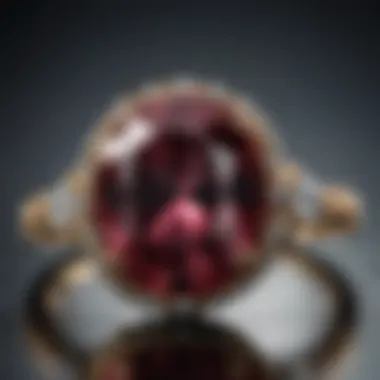
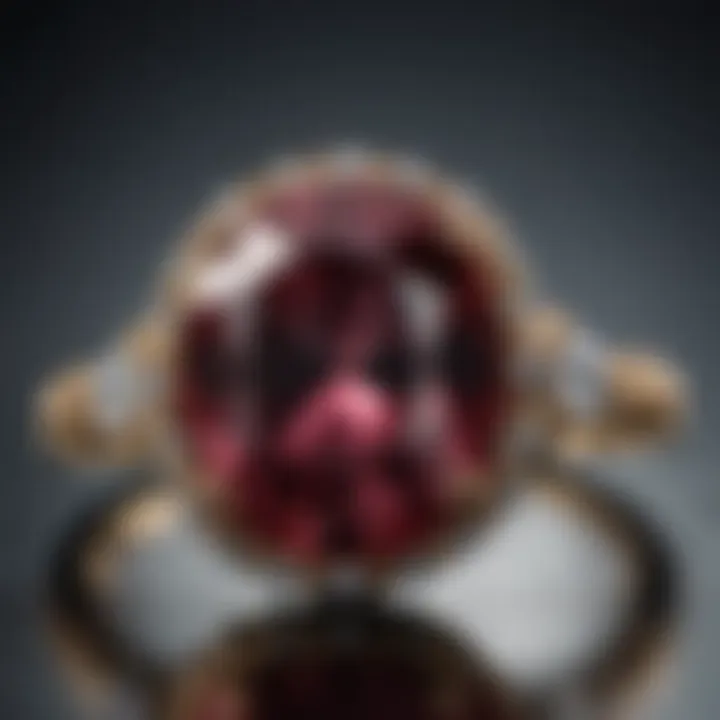
Maintenance and Cleaning Methods
To maintain the beauty of sapphires, proper cleaning is essential. Regular gentle cleaning can remove dirt and oils that accumulate over time. Use a mixture of warm water and mild soap, and a soft toothbrush for delicate cleaning. Avoid harsh chemicals and ultrasonic cleaners which can damage the stone.
It is also wise to have your sapphire jewelry professionally cleaned and inspected periodically. This helps in identifying potential issues such as loose settings or scratches, ensuring the longevity of your gemstone.
Storing Sapphires Safely
When it comes to storing sapphires, safety is paramount. Store sapphires in a soft cloth pouch or a lined jewelry box to prevent scratches from other jewelry pieces. If you own multiple gemstones, segregate them to avoid friction damage.
Also, consider the environmental conditions of your storage. Avoid exposure to extreme temperatures and humidity, as these factors can compromise the integrity of gemstones. Ensure that the storage area is secure and safe from theft or loss.
Keeping your sapphires in optimal conditions will help preserve their charm and value for years.
In summary, investing in quality sapphires requires knowledge. Understanding the buying process, maintenance, and storage is vital. These practices not only protect your investment but also allow you to enjoy the true beauty of your sapphires.
Market Trends and Investment Considerations
Understanding the market trends related to sapphires is crucial for any gemstone enthusiast or investor. The sapphire market has seen fluctuations over the years, influenced by various factors like supply, demand, and changes in consumer preferences. Analyzing these trends provides valuable insights into making informed investments in sapphires.
Current Market Trends for Sapphires
Today, sapphires remain one of the most sought-after gemstones in the world. Recent trends indicate a growing interest in ethically sourced and lab-created sapphires. Consumers are becoming more conscious of the origins of their gemstones. This movement highlights the importance of transparency in the gemstone industry. In some markets, this has resulted in a shift towards lab-created options due to their lower costs and ethical implications.
Another noticeable trend is the rising popularity of unique colors and cuts. While blue sapphires still dominate the market, colors like pink and yellow are receiving increasing attention. Fashion and jewelry designers are now experimenting more with unconventional cuts, enhancing the appeal of these gemstones.
Sapphire prices can vary significantly depending on the source and characteristics. Recent reports show that high-quality sapphires from Sri Lanka and Kashmir command higher prices due to their rarity and historical significance. Conversely, sapphires from other regions may be more accessible but still maintain value.
Factors Affecting Sapphire Values
Several elements influence the value of sapphires. Clarity, color, cut, and carat weight are pivotal factors:
- Color: Rich, deep colors usually yield higher value. The vivid blue sapphires from Kashmir are particularly prized.
- Clarity: Sapphires with fewer inclusions and better transparency are more valuable.
- Cut: An expertly cut sapphire showcases its color and brilliance, enhancing its value. Different cuts may also attract specific market segments.
- Carat Weight: Larger sapphires generally have a higher price per carat, though this can vary with other quality factors.
Additionally, market dynamics can also affect prices. Economic conditions, gem demand, and even social media influence trends in the sapphire market. Seasonal demands, such as during holidays or wedding seasons, can lead to temporary spikes in price. International markets can also create shifts, as buyers from different countries bring varying preferences to the sapphire market.
"Staying informed about sapphire market trends can significantly affect investment outcomes. Knowing what affects sapphire values helps buyers make smarter choices."
The End: The Enduring Allure of the September Birthstone
The September birthstone, especially the sapphire, holds a unique place in the realm of gemstones. This conclusion encapsulates the themes presented throughout this article, highlighting the blend of historical significance, cultural relevance, and practical insights that define the allure of this stone. The sapphire, with its rich hues and diverse symbolism, transcends merely being a birthstone. It embodies qualities that resonate with many people, making it not just a personal token but also a gem with potential investment value.
The journey through sapphires reveals their physical properties that not only dazzle the eye but also represent ideals such as wisdom, loyalty, and nobility. These traits have made the sapphire a favored choice in various traditions throughout history. This gemstone's vibrant colors and its durability contribute to its status as a coveted object in the jewelry market. As discussed, the September birthstone is not merely a matter of personal preference; it reflects broader cultural trends and values.
In our exploration, we also considered market trends, providing insights into how current economic factors can affect the value of sapphires. Collectors and enthusiasts benefit from understanding these trends, enabling informed decisions regarding purchases in a fluctuating market. Knowing how to care for these stones ensures they remain in pristine condition, safeguarding the investment made.
Ultimately, the allure of the September birthstone lies in its combination of beauty and significance. Many seek to possess sapphires not just for their aesthetic appeal but for the deeper meanings they convey. By understanding these aspects, individuals can appreciate the sapphire beyond its surface, recognizing its role in personal and cultural narratives.
"Sapphires are more than just beautiful gems; they represent a connection to history, values, and personal stories."
Understanding sapphires and their context allows enthusiasts to grow in their appreciation and connection to this remarkable gemstone.
Recap of Key Points
- Historical Context: Sapphires have been valued through centuries, seen as symbols of nobility and protection.
- Physical Properties: The durability and beauty of sapphires make them ideal for daily wear and special occasions.
- Cultural Symbolism: The stone's association with wisdom and clarity enhances its significance in various cultures.
- Market Insights: Current market trends and investment considerations are critical for collectors and jewelry enthusiasts.
- Care and Maintenance: Proper care is essential to maintain the beauty and value of sapphires over time.
Final Thoughts on Sapphires
In a world increasingly focused on materialistic values, the sapphire stands as a bridge between beauty and significance, offering a sense of nostalgia and aspiration.







